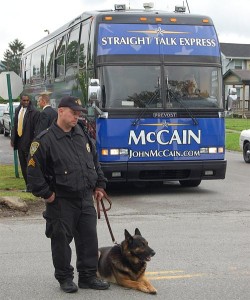 During the 2000 presidential campaign, David Foster Wallace, the novelist, essayist and humorist best known for his 1996 novel “Infinite Jest,” covered John McCain‘s unsuccessful bid to become the Republican Party’s nominee for President for Rolling Stone Magazine. He rode with McCain’s Straight Talk Express for a week in February of that year and wrote a 15,000 + word essay titled “The Weasel, Twelve Monkeys and The Shrub” that took a look at everything from the campaign’s political strategy to the food it catered for the staff. [To read the edited version published in the magazine, you have to subscribe to the Rolling Stone On-line edition. Or you can buy a copy of the book titled McCain’s Promise: Aboard the Straight Talk Express with John McCain and a Whole Bunch of Actual Reporters, Thinking About Hope, which includes the entire essay.]
During the 2000 presidential campaign, David Foster Wallace, the novelist, essayist and humorist best known for his 1996 novel “Infinite Jest,” covered John McCain‘s unsuccessful bid to become the Republican Party’s nominee for President for Rolling Stone Magazine. He rode with McCain’s Straight Talk Express for a week in February of that year and wrote a 15,000 + word essay titled “The Weasel, Twelve Monkeys and The Shrub” that took a look at everything from the campaign’s political strategy to the food it catered for the staff. [To read the edited version published in the magazine, you have to subscribe to the Rolling Stone On-line edition. Or you can buy a copy of the book titled McCain’s Promise: Aboard the Straight Talk Express with John McCain and a Whole Bunch of Actual Reporters, Thinking About Hope, which includes the entire essay.]
 In one section of the essay, Wallace writes that younger voters can’t identify with political leaders because they instinctively sense “bullshit.” He feels that the entire generation born post-1970 [Generation X] was raised with commercials and can’t help but look at the political process as one big commercial. Wallace goes on to argue that voters “below the age of 35″ [make that voters under the age of 45 today, considering that the essay was penned over ten years ago] can “smell” the self serving interests a political candidate has when they ask for votes. No matter what they promise. Wallace says, “We may vote for them the same way we may go buy toothpaste. But we’re not inspired. They’re not the real thing.”
In one section of the essay, Wallace writes that younger voters can’t identify with political leaders because they instinctively sense “bullshit.” He feels that the entire generation born post-1970 [Generation X] was raised with commercials and can’t help but look at the political process as one big commercial. Wallace goes on to argue that voters “below the age of 35″ [make that voters under the age of 45 today, considering that the essay was penned over ten years ago] can “smell” the self serving interests a political candidate has when they ask for votes. No matter what they promise. Wallace says, “We may vote for them the same way we may go buy toothpaste. But we’re not inspired. They’re not the real thing.”
Wallace then goes on to describe what he means by a real leader.
“A real leader can somehow get us to do certain things that deep down we think are good and want to be able to do but usually can’t get ourselves to do on our own. It’s a mysterious quality, hard to define, but we always know it when we see it, even as kids. [Real leaders] help us overcome the limitations of our own individual laziness and selfishness and weakness and fear and get us to do better, harder things than we can get ourselves to do on our own.”
In my leadership programs over the past few years, I’ve asked each group of participants to create their own definition of leadership. Every group seems to start out with Wallace’s thought that it is hard-to-define-but-we-know-it-when-we-see-it. Then they start stringing together lists of traits and behaviors that are characteristic of people that they recognize as leaders. Finally, they boil down the lists and arrange the terms and phrases into pictograms that display their definition of leadership. Here are a few of them:


 The elements they have in common are pretty obvious. Leaders want to influence other people; to get them to buy-in to some shared vision, to something that is important and gives meaning to their lives. Real leaders know that the foundation of the relationship with those who follow them is acting with integrity and being worthy of trust. We won’t follow someone if we think that they are acting solely out of self-interest. We won’t follow someone we can’t trust. Even kids know that. Why is it so hard for our political leaders to figure it out?
The elements they have in common are pretty obvious. Leaders want to influence other people; to get them to buy-in to some shared vision, to something that is important and gives meaning to their lives. Real leaders know that the foundation of the relationship with those who follow them is acting with integrity and being worthy of trust. We won’t follow someone if we think that they are acting solely out of self-interest. We won’t follow someone we can’t trust. Even kids know that. Why is it so hard for our political leaders to figure it out?
Authentic leaders (and not all are authentic.. e.g..pipe pipers) articulate the inexplicable intrinsic values of man. That is why great leaders ,i.e. Buddha, Socretes, Lao Tse, Jesus, Ramakrishna, taught in parables not explicit ….just the facts commands. Be like water. It’s always at the right level.